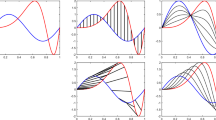Abstract
Interpolation and gridding of data are procedures in the physical sciences and are accomplished typically using an averaging or finite difference scheme on an equidistant grid. Cubic splines are popular because of their smooth appearances; however, these functions can have undesirable oscillations between data points. Adding tension to the spline overcomes this deficiency. Here, we derive a technique for interpolation and gridding in one, two, and three dimensions using Green's functions for splines in tension and examine some of the properties of these functions. For moderate amounts of data, the Green's function technique is superior to conventional finite-difference methods because (1) both data values and directional gradients can be used to constrain the model surface, (2) noise can be suppressed easily by seeking a least-squares fit rather than exact interpolation, and (3) the model can be evaluated at arbitrary locations rather than only on a rectangular grid. We also show that the inclusion of tension greatly improves the stability of the method relative to gridding without tension. Moreover, the one-dimensional situation can be extended easily to handle parametric curve fitting in the plane and in space. Finally, we demonstrate the new method on both synthetic and real data and discuss the merits and drawbacks of the Green's function technique.
Similar content being viewed by others
REFERENCES
Abramowitz, M., and Stegun, I., eds., 1970, Handbook of mathematical functions: Dover, New York, 1046 p.
Bracewell, R. N., 1978, The Fourier transform and its applications (2nd ed.): McGraw-Hill Book Co., London, 444 p.
Briggs, I. C., 1974, Machine contouring using minimum curvature: Geophysics, v. 39,no. 1, p. 39–48.
Clark, I., 1979, Practical geostatistics: Applied Science Publ., London, 129 p.
Cline, A., 1974, Scalar and planar-value curve fitting using splines under tension: Comm. ACM., v. 17, p. 218–223.
Davis, J. C., 1986, Statistics and data analysis in geology (2 ed.): John Wiley & Sons, New York, 646 p.
Greenberg, M. D., 1971, Application of Green's functions in science and engineering: Prentice-Hall, Englewood Cliffs, New Jersey, 141 p.
Hardy, R. L., 1971, Multiquadric equations of topography an otehr irregular surfaces: Jour. Geophys. Res., v. 76,no. 8, p. 1905–1915.
Hardy, R. L., and Nelson, S. A., 1986, A multiquadric-biharmonic representation and approximation of the disturbing potential: Geophys. Res. Lett., v. 13,no. 1, p. 18–21.
Inoue, H., 1986, A least-squares smooth fitting for irregularly spaced data: Finite-element approach using the cubic B-spline basis: Geophysics, v. 51,no. 11, p. 2051–2066.
Menke, W., 1991, Applications of the POCS inversion method to interpolating topography and other geophysical fields: Geophys. Res. Lett., v. 18,no. 3, p. 435–438.
Mitásová, H., and Mitás, L., 1993, Interpolation by regularized spline with tension: I. Theory and implementation: Math. Geology, v. 25,no. 6, p. 641–655.
Olea, R. A., 1974, Optimal contour mapping using universal kriging: Jour. Geophys. Res. v. 79,no. 5, p. 696–702.
Sandwell, D. T., 1987, Biharmonic spline interpolation of Geos-3 and Seasat altimeter data: Geophys. Res. Lett., v. 14,no. 2, p. 139–142.
Schweikert, D. G., 1966, An interpolating curve using a spline in tension: Jour. Math. Physics, v. 45, p. 312–317.
Smith, W. H. F., and Wessel, P., 1990, Gridding with continuous curvature splines in tension: Geophysics, v. 55,no. 3, p. 293–305.
Swain, C. J., 1976, A FORTRAN IV program for interpolating irregularly spaced data using the difference equations for minimum curvature: Computers & Geosciences, v. 1,no. 4, p. 231–240.
Timoshenko, S., and Woinowsky-Krieger, S., 1959, Theory of plates and shells (2nd ed.): McGraw-Hill Book Co., New York, 580 p.
Wegman, E. J., and Wright, I. W., 1983, Splines in statistics: Jour. Am. Stat. Assoc., v. 78,no. 382, p. 351–365.
Wessel, P., and Smith, W. H. F., 1991, Free software helps map and display data: EOS Trans. AGU, v. 72,no. 41, p. 441, 445–446.
Wessel, P., and Smith, W. H. F., 1995, New version of the generic mapping tools released: EOS Trans. AGU, v. 76,no. 33, p. 329.
Wessel, P., and Smith, W. H. F., 1996, A global, self-consistent, hierarchical, high-resolution shoreline database: Jour. Geophys. Res., v. 101,no. B4, p. 8741–8743.
Author information
Authors and Affiliations
Rights and permissions
About this article
Cite this article
Wessel, P., Bercovici, D. Interpolation with Splines in Tension: A Green's Function Approach. Mathematical Geology 30, 77–93 (1998). https://doi.org/10.1023/A:1021713421882
Issue Date:
DOI: https://doi.org/10.1023/A:1021713421882




